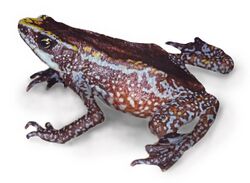Biology:Atelopus chiriquiensis
| Atelopus chiriquiensis | |
|---|---|

| |
| Scientific classification | |
| Domain: | Eukaryota |
| Kingdom: | Animalia |
| Phylum: | Chordata |
| Class: | Amphibia |
| Order: | Anura |
| Family: | Bufonidae |
| Genus: | Atelopus |
| Species: | A. chiriquiensis
|
| Binomial name | |
| Atelopus chiriquiensis Shreve, 1936
| |
Atelopus chiriquiensis, the Chiriqui harlequin frog[2] or Lewis' stubfoot toad, is an extinct species of toad in the family Bufonidae that was found in the Cordillera de Talamanca in Costa Rica and western Panama (Province and Bocas del Toro Provinces).[1][3] Its natural habitats were stream margins in lower montane wet forests and rainforests. Its elevational range was 1,400–2,500 m (4,600–8,200 ft) asl.[1]
Description
Atelopus chiriquiensis was a moderately sized toad: males measure 28–34 mm (1.1–1.3 in) in snout–vent length and females 36–49 mm (1.4–1.9 in). Colouring was highly variable and usually different between males and females. They had weakly developed and relatively inconspicuous poison glands scattered over the head and dorsum; nevertheless, they produced tetrodotoxin and aminoacid analog chiriquitoxin , a potent neurotoxin.[2]
Anatomy
The toad lacks a middle ear and uses other means to transfer sound to the inner ear. The structure responsible for this is the body wall overlying the lung.[4][5][6]
Conservation status
This once locally abundant species has not been seen in Costa Rica since 1996 and is considered extinct in the country. It is also thought to have disappeared from Panama as there are no records since late 1990s. The decline was probably linked to chytridiomycosis. Habitat loss and introduced trout were also threats.[1] The IUCN Red List now considers Atelopus chiriquiensis extinct.[7]
References
- ↑ 1.0 1.1 1.2 1.3 IUCN SSC Amphibian Specialist Group (2020). "Atelopus chiriquiensis". IUCN Red List of Threatened Species 2020: e.T54498A54340769. doi:10.2305/IUCN.UK.2020-3.RLTS.T54498A54340769.en. https://www.iucnredlist.org/species/54498/54340769. Retrieved 16 November 2021.
- ↑ 2.0 2.1 "Atelopus chiriquiensis". AmphibiaWeb: Information on amphibian biology and conservation. [web application]. Berkeley, California: AmphibiaWeb. 2014. http://amphibiaweb.org/cgi/amphib_query?where-genus=Atelopus&where-species=chiriquiensis. Retrieved 24 November 2014.
- ↑ Frost, Darrel R. (2014). "Atelopus chiriquiensis Shreve, 1936". Amphibian Species of the World: an Online Reference. Version 6.0. American Museum of Natural History. http://research.amnh.org/vz/herpetology/amphibia/Amphibia/Anura/Bufonidae/Atelopus/Atelopus-chiriquiensis. Retrieved 24 November 2014.
- ↑ Jaslow, Alan P. (1979). "Vocalization and Aggression in Atelopus chiriquiensis (Amphibia, Anura, Bufonidae)". Journal of Herpetology 13 (2): 141–145. doi:10.2307/1563919. ISSN 0022-1511. https://www.jstor.org/stable/1563919.
- ↑ Jaslow, Alan P.; Lombard, R. Eric (1996). "Hearing in the Neotropical Frog, Atelopus chiriquiensis". Copeia 1996 (2): 428–432. doi:10.2307/1446859. ISSN 0045-8511. https://www.jstor.org/stable/1446859.
- ↑ Lindquist, E. D.; Hetherington, T. E.; Volman, S. F. (1998-07-01). "Biomechanical and neurophysiological studies on audition in eared and earless harlequin frogs (Atelopus)" (in en). Journal of Comparative Physiology A 183 (2): 265–271. doi:10.1007/s003590050254. ISSN 1432-1351. PMID 9693994. https://doi.org/10.1007/s003590050254.
- ↑ Ssc), IUCN SSC Amphibian Specialist Group (IUCN (2019-09-10). "IUCN Red List of Threatened Species: Atelopus chiriquiensis". https://www.iucnredlist.org/fr.
Wikidata ☰ Q2044272 entry
 |


